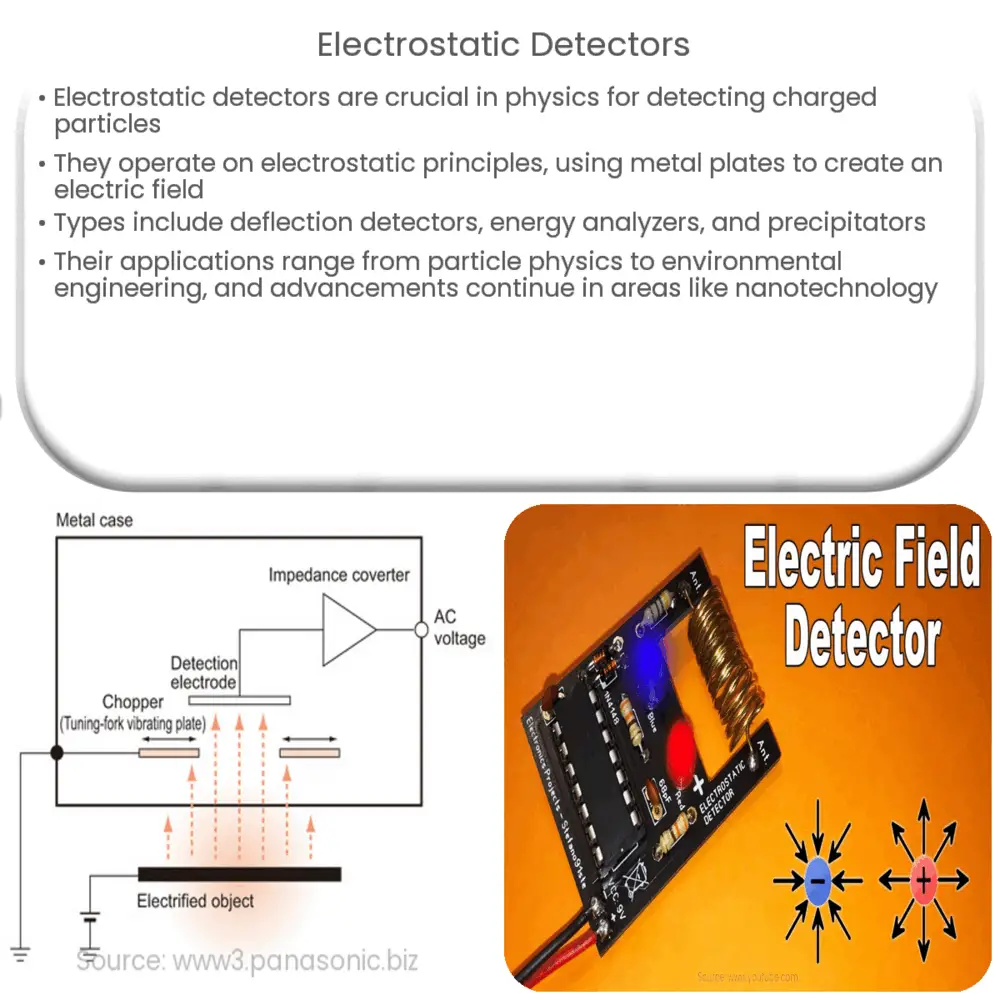Explore the world of electrostatic detectors, their working principles, applications, challenges, advancements, and emerging trends in technology.

Introduction to Electrostatic Detectors
Electrostatic detectors are vital instruments in various fields of physics, particularly in particle physics and nuclear physics. They leverage the fundamental principles of electrostatics to detect and measure various properties of charged particles.
Working Principle of Electrostatic Detectors
An electrostatic detector operates based on the principles of electrostatics, a branch of physics that studies the effects of stationary electric charges. These detectors typically comprise two or more metal plates or grids with a voltage applied across them. This voltage creates an electric field between the plates.
When a charged particle enters this field, it experiences a force due to the field’s electrostatic potential. This force causes the particle to move along a specific trajectory. By analyzing the resulting movements of these particles, scientists can discern vital information about their properties.
Types of Electrostatic Detectors
- Electrostatic Deflection Detectors: These are used to deflect charged particles to analyze their paths. This type of detector is often found in cathode ray tubes.
- Electrostatic Energy Analyzers: They are used to separate particles based on their energy levels. This analyzer type is widely used in spectrometry.
- Electrostatic Precipitators: Although not a detector in the conventional sense, they are critical devices in environmental engineering that use electrostatics to remove particles from gases.
Applications of Electrostatic Detectors
Due to their capacity to detect and measure charged particles, electrostatic detectors are extensively used in various fields.
- Particle Physics: Electrostatic detectors play a significant role in detecting charged particles in accelerators and colliders.
- Nuclear Physics: They are used to analyze radiation particles and energy spectra in nuclear experiments.
- Environmental Engineering: Electrostatic detectors, in the form of electrostatic precipitators, are used to clean exhaust gases in industrial processes.
In the following sections, we’ll delve deeper into the science behind these devices, the challenges in their design and implementation, and their emerging trends in technology.
Science Behind Electrostatic Detectors
As stated earlier, electrostatic detectors function on the basis of the principles of electrostatics. When a charged particle enters the electric field created by the voltage difference between the detector’s metal plates, it is either attracted or repelled based on the polarity of the charge. This force alters the trajectory of the particle, which is then monitored and studied.
Depending on the type of detector, different properties of the particle can be measured. For instance, an electrostatic energy analyzer can determine the energy of the particles by analyzing their deflection.
Challenges and Advancements
Despite their immense utility, electrostatic detectors are not without their challenges. They are sensitive to noise and require a high degree of precision in their construction and alignment. They can also struggle with particles of low energy or low charge, as these can be harder to detect.
However, continual advancements in technology are working to mitigate these challenges. Improvements in materials science have led to more efficient and precise detectors. Furthermore, the integration of advanced computational techniques and algorithms for data analysis has significantly enhanced the accuracy of these devices.
Emerging Trends
One exciting trend in the field is the integration of electrostatic detectors with nanotechnology. For instance, nanowires and nanotubes are being used to enhance the sensitivity and efficiency of these detectors. Moreover, the development of miniaturized electrostatic detectors is opening up new possibilities for their application in areas like medicine, space exploration, and more.
Conclusion
In conclusion, electrostatic detectors are vital scientific instruments that have facilitated numerous breakthroughs in various fields, from particle physics to environmental engineering. Despite some challenges, ongoing advancements and emerging trends promise an exciting future for these devices. As our understanding of charged particles continues to grow, so too will our ability to detect and analyze them, leading to even more discoveries and applications of these remarkable devices.

